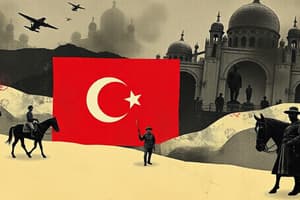Podcast
Questions and Answers
What were janissaries trained to be?
What were janissaries trained to be?
- Administrators (correct)
- Foot soldiers (correct)
- Architects
- Farmers
What significant battle did the Ottomans win in 1389?
What significant battle did the Ottomans win in 1389?
Battle of Kosovo
Who was Mehmed II?
Who was Mehmed II?
The Ottoman leader who ended the Byzantine Empire.
What was the outcome of the siege of Constantinople?
What was the outcome of the siege of Constantinople?
What significant areas did Sultan Selim I conquer?
What significant areas did Sultan Selim I conquer?
Which of the following achievements is attributed to Süleyman I?
Which of the following achievements is attributed to Süleyman I?
What characterizes a gunpowder empire?
What characterizes a gunpowder empire?
What is a sultan?
What is a sultan?
What does the term 'harem' refer to in the Ottoman context?
What does the term 'harem' refer to in the Ottoman context?
What role did the queen mother have?
What role did the queen mother have?
Who was the grand vizier?
Who was the grand vizier?
What were pashas responsible for?
What were pashas responsible for?
What is significant about Topkapi?
What is significant about Topkapi?
What did the ulema administer?
What did the ulema administer?
Non-Muslims paid a tax but were allowed to practice their religion or convert to __________.
Non-Muslims paid a tax but were allowed to practice their religion or convert to __________.
What rights did women have in the Ottoman Empire?
What rights did women have in the Ottoman Empire?
What types of products did Ottoman artists create?
What types of products did Ottoman artists create?
How were Ottoman mosques modeled?
How were Ottoman mosques modeled?
Who was Sinan?
Who was Sinan?
What did Justinian introduce to the West?
What did Justinian introduce to the West?
What did silk industries produce?
What did silk industries produce?
Study Notes
Ottoman Military and Political Structure
- Janissaries were elite foot soldiers and administrators trained to serve the sultan.
- The Battle of Kosovo in 1389 marked a significant victory for the Ottomans over the Serbs, strengthening their influence in the region.
Conquest and Expansion
- Mehmed II initiated the end of the Byzantine Empire by besieging Constantinople with a force of 80,000 against 7,000 defenders.
- Constantinople fell after nearly two months of bombardment, leading to a brutal three-day sack and linking Europe and Asia under Ottoman control.
Sultanate and Leadership
- Sultan Selim I expanded the empire by conquering Mesopotamia, Egypt, and Arabia, declaring himself caliph, or defender of the Islamic faith.
- Under Süleyman I, the Ottomans seized Belgrade and expanded into Hungary, reaching Vienna before suffering defeat in 1529.
- The Ottoman Empire’s shift in focus to maritime trade routes occurred after European expansion following the loss in Hungary.
Governance and Administration
- Sultan's status grew with the empire's expansion, moving towards a centralized administrative system while becoming isolated from the populace.
- The harem served as the private residence for the sultan and his wives, and the queen mother acted as a vital adviser when her son ascended the throne.
- The grand vizier facilitated council meetings, with the sultan overseeing proceedings discreetly yet exerting influence privately.
Societal Structure
- Pashas were responsible for tax collection and military supply from their territories.
- The ulema administered legal systems and education, implementing Islamic law for Muslims within the empire.
- Non-Muslims paid a tax but retained religious practices. Land ownership was centralized under the sultan, with artisans organized in craft guilds providing social and financial support.
Role of Women and Cultural Development
- Women in the empire could own property, choose marriage, and initiate divorce, gaining significant power within domestic spaces.
- Artists produced various crafts, including pottery and textiles, contributing to the opulence of the sultan's palaces.
Architectural Achievements
- Mosques were inspired by Byzantine architecture, particularly the Hagia Sophia, characterized by large central domes.
- Sinan, an iconic architect, designed the Süleymaniye Mosque, noted for its grand domes and minarets, symbolizing Ottoman architectural prowess.
Economic Practices
- Silk industries flourished, with factories producing textiles for royal use, while rural artisans crafted rugs from wool and cotton, establishing a peasant-based industry.
Studying That Suits You
Use AI to generate personalized quizzes and flashcards to suit your learning preferences.
Description
Explore the military and political structure of the Ottoman Empire, including the role of the Janissaries and key battles that shaped the empire's influence. Learn about significant conquests, including the fall of Constantinople and the expansion under notable sultans like Mehmed II and Süleyman I.




